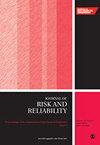基于风险的飞机燃气涡轮发动机部件维修优化
IF 1.8
4区 工程技术
Q3 ENGINEERING, INDUSTRIAL
Proceedings of the Institution of Mechanical Engineers Part O-Journal of Risk and Reliability
Pub Date : 2022-11-27
DOI:10.1177/1748006x221135907
引用次数: 1
摘要
飞机燃气涡轮发动机的完整性对飞行安全至关重要。虽然发动机的可靠性有了很大的提高,但大量的传统发动机仍在继续运行。由于成本高昂,传统发动机的维护是运营商的主要负担,而且对飞行安全构成了很大的风险。在本研究中,我们开发了一种基于风险的飞机发动机部件维修优化的综合方法。该方法使用了一个物理数据驱动模型,结合了韦贝斯模型和一个简单的疲劳裂纹扩展模型。利用贝叶斯更新和无损检测可靠性知识对裂纹长度分布和相应的风险进行了评估。利用该模型对CT7-9C涡桨发动机一级叶盘的疲劳可靠性进行了计算。采用单断裂进行韦贝叶斯分析,基于定量断口的裂纹扩展分析得到主裂纹扩展曲线。在此基础上,建立了基于现场检查人员评价的检查模型,得到了后裂纹长度分布,并通过灵敏度分析,识别出了重要影响因素。最后,利用近似目标函数和约束函数,制定了最优检测和更换方案。特别是,在将风险保持在严格限制范围内的同时,将生命周期成本最小化。本文章由计算机程序翻译,如有差异,请以英文原文为准。
Risk-based maintenance optimization of aircraft gas turbine engine component
The integrity of an aircraft gas turbine engine is critical for safety of flight. Although the reliability of engines has improved considerably, a large number of legacy engines continue to operate. The maintenance of legacy engines is a major burden for their operators owing to the high cost involved, and the engines pose a high risk to flight safety. In this study, we developed a comprehensive approach for risk-based maintenance optimization of aircraft engine components. The approach involved the use of a physics-informed data-driven model incorporated with the Weibayes model and a simple fatigue crack growth model. The crack length distribution and corresponding risks were evaluated using Bayesian updating and knowledge of nondestructive inspection reliability. The model was used for the computation of the fatigue reliability of the first-stage blisk of a CT7-9C turboprop engine. A single failure was used for the Weibayes analysis, and a master crack growth curve was obtained through quantitative-fractography-based crack growth analysis. Furthermore, an inspection model based on the evaluation of field inspectors was used to obtain the posterior crack length distribution, and through a sensitivity analysis, important factors were identified. Finally, optimal inspection and replacement plans were formulated using approximated objective and constraint functions. In particular, the life-cycle cost was minimized while maintaining the risks within strict limits.
求助全文
通过发布文献求助,成功后即可免费获取论文全文。
去求助
来源期刊

Proceedings of the Institution of Mechanical Engineers Part O-Journal of Risk and Reliability
ENGINEERING, MULTIDISCIPLINARY-ENGINEERING, INDUSTRIAL
CiteScore
4.50
自引率
19.00%
发文量
81
审稿时长
6-12 weeks
期刊介绍:
The Journal of Risk and Reliability is for researchers and practitioners who are involved in the field of risk analysis and reliability engineering. The remit of the Journal covers concepts, theories, principles, approaches, methods and models for the proper understanding, assessment, characterisation and management of the risk and reliability of engineering systems. The journal welcomes papers which are based on mathematical and probabilistic analysis, simulation and/or optimisation, as well as works highlighting conceptual and managerial issues. Papers that provide perspectives on current practices and methods, and how to improve these, are also welcome
 求助内容:
求助内容: 应助结果提醒方式:
应助结果提醒方式:


